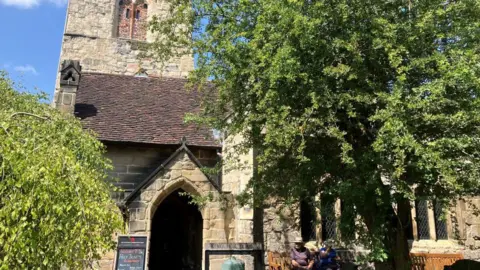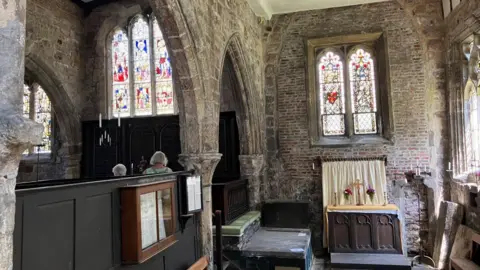The story behind 'birthplace of lesbian marriage'
 Hannah Sackville-Bryant/BBC
Hannah Sackville-Bryant/BBCTucked away in a secluded street near York Minster, a stone's throw from one of the city's busiest shopping streets, is a church that played a fascinating role in lesbian history.
Holy Trinity on Goodramgate, which dates back to the 12th Century, is where diarist and businesswoman Anne Lister "married" her partner, heiress Ann Walker, on Easter Sunday in 1834.
Although same-sex marriage was not legal at the time, they took the sacrament together at Holy Communion and considered themselves wedded.
Sarah Cowling, Churches Conservation Trust volunteer and Blue Badge tour guide, said that as a result, Holy Trinity really became the "birthplace of lesbian marriage".
Although Lister's family owned the Shibden Hall estate near Halifax, she had a strong association with York, where she attended school and met many of her friends.
After a two-year courtship with Walker, daughter of a Halifax landowner, Lister chose to take the sacrament to "have something as close to a marriage as they could possibly get", Ms Cowling said.
"In the February, they had pledged themselves to each other, and later on they had exchanged rings and made provisions to each other in their wills," she explained.
Helena Whitbread, a historian and the editor and decoder of Lister's secret diaries, said she had three criteria for becoming "married": exchanging rings; declaring their love; and taking a vow before the altar.
Lister wrote in her diary on 27 March 1834 that she and Walker were "positively engaged", Ms Whitbread said.
Then, on 30 March, the couple attended the Easter Sunday service at Holy Trinity in York - both wearing their wedding rings.
Holy Trinity was chosen partly because the Holy Communion did not feature in many Anglican services.
The tradition of sharing bread and wine was always part of a marriage ceremony.
"That was their opportunity between now and Christmas time to take Communion together," Ms Cowling said.
The church was a convenient option as they both had appointments in nearby Minster Yard, and Walker was staying in the village of Heworth.
Taking the sacrament was "momentous", Ms Cowling said.
"Lister's diaries are the first written record, and so the first clear intent we've got, of any two women deciding they want to live in a marital-style relationship.
"Undoubtedly, women did before Anne, but we have no proof."
However, Lister's intentions were not completely romantic: she wished to access Walker's considerable family fortune.
Meanwhile, Ms Whitbread said it was also a way for Lister to affirm her gender identity.
"Anne needed to acquire the role of 'husband' in a relationship with a woman in order to boost her sense of her masculinity," she said.
"Psychologically, marriage is a necessity to Anne as a confirmation to herself that she has a right to marry - that is, to become a husband - a role which would bolster the masculine traits in her character."
 Hannah Sackville-Bryant/BBC
Hannah Sackville-Bryant/BBCHowever, Ms Whitbread added that there was evidence Walker did not attach as much value to the ceremony as Lister did.
"Even though they both had their rings on, she didn't seem to give as much importance to it," she said.
"It seemed a bit one-sided to me. In Anne's eyes, the ceremony should have sealed the matrimonial pact into which they had entered.
"Anne should have explained to Walker a bit more before going to the church, so Walker was more aware of the significance, but she didn't.
"She knelt at the altar with her thoughts and prayers, then walked out."
Walker later moved in with Lister and her family at Shibden Hall.
Lister died in 1840 while travelling in Georgia with Walker, who died in 1854 having returned to live on her family's Crow Nest estate in Halifax.
Listen to highlights from North Yorkshire on BBC Sounds, catch up with the latest episode of Look North.
